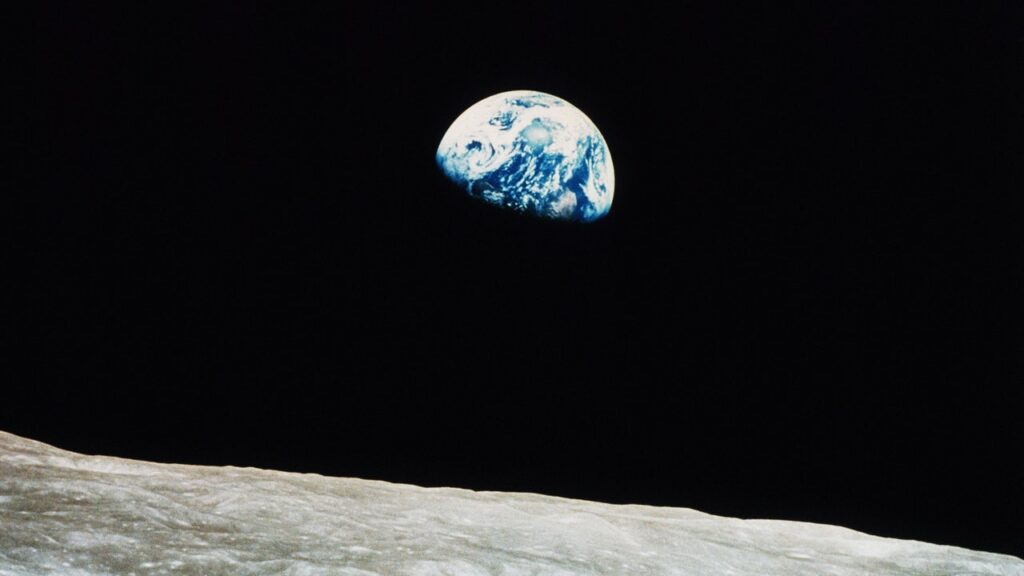“Huge change is now afoot.” A look back at the first Earth Day, exploring the ways our planet is now in peril—and how we might find hope. Plus:
Photograph from Getty
Bill McKibben
McKibben writes about climate policy and the environment.
The inaugural Earth Day, on April 22, 1970, had many triggers: an oil spill in Santa Barbara, a river that kept catching fire in Cleveland. But possibly the most important incentive was a picture that arrived, sixteen months earlier, from Apollo 8. “Earthrise,” as it came to be known, showed a blue-and-white orb floating through black space. (“You got a color film, Jim?” Bill Anders asked his fellow-astronaut Jim Lovell. “Hand me a roll of color, quick, would you?”) With that image, we saw where we lived for the first time.
Earth doesn’t look like it did in that image anymore. After millennia of stability, huge change is now afoot. For one thing, there’s a lot less white up north, in the Arctic, where sea ice covered less surface this winter than ever before. And, though you can’t see it with the naked eye, the thin layer of atmosphere that makes our planet so special is markedly different: the amount of carbon dioxide in the air is more than fifty per cent higher now than it was before the Industrial Revolution; last year saw the single largest increase ever measured, amid other signs of our forests’ diminishing ability to sequester carbon. By some measures, March, 2025, was the hottest March ever observed. In short, the Earth that we’re meant to honor on Earth Day is in far worse trouble than anyone could have predicted fifty-five years ago, as they were celebrating the planet and raising awareness for its preservation.
But those environmentalists would have recognized, at least a little, the political climate: a corrupt Republican Administration and an energized populace willing to take to the streets. Then, as now, the Earth’s well-being was just one of the issues on people’s minds, but the enduring power of that first Earth Day really did change American politics: by the end of the year, Richard Nixon (arguably no environmental advocate) had signed the Clean Air Act and established the Environmental Protection Agency. And the Clean Water Act came a couple of years later. That those precise laws and agencies are now being systematically gutted should send us back to the streets.
For a little hope: the dollar price of energy from the sun has fallen by a factor of a hundred since 1970. They didn’t have Google Earth then, but now, if you zoom in on the right places, you can see solar panels spreading over the landscape like mushrooms after a rain. That’s our chance this time around.
For more: read McKibben on how solar fields are perfect for pollinators; how a state can power itself without fossil fuels; and how cheap green energy is finally within reach.
Editor’s Pick
The Mexican President Who’s Facing Off with Trump
Can Claudia Sheinbaum manage the demands from D.C.—and her own country’s fragile democracy? Stephania Taladrid profiles the country’s first female President »
More Top Stories
Daily Cartoon
More Fun & Games
P.S. Every year, when the spring sun finally reëmerges after a gloomy winter, the burst of accompanying flowers brings hope. “All that color has a practical purpose,” Alex Ross wrote on the occasion, in 2016, of an exceptional California superbloom. “But it was hard not to see it symbolically, as a defiant assertion of life in the face of death.” 🌻🌿🌷🌳
Premium IPTV Experience with line4k
Experience the ultimate entertainment with our premium IPTV service. Watch your favorite channels, movies, and sports events in stunning 4K quality. Enjoy seamless streaming with zero buffering and access to over 10,000+ channels worldwide.

















